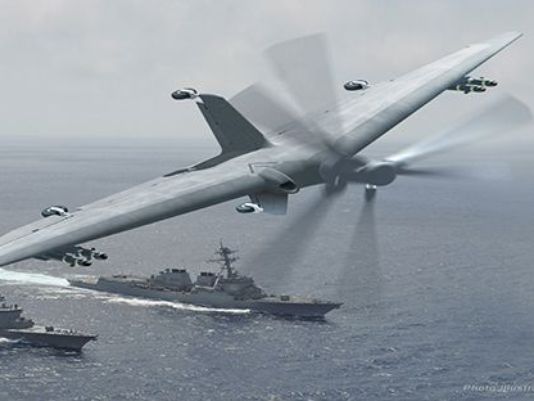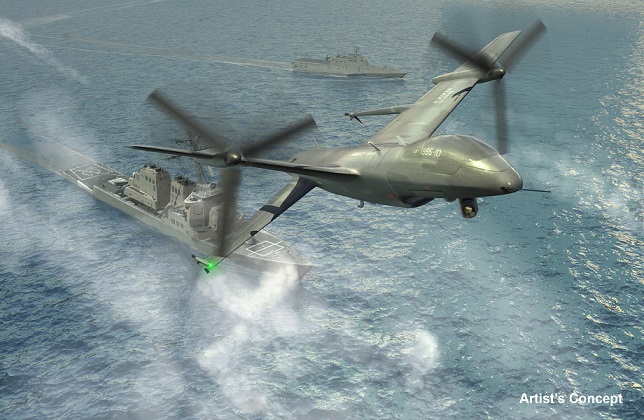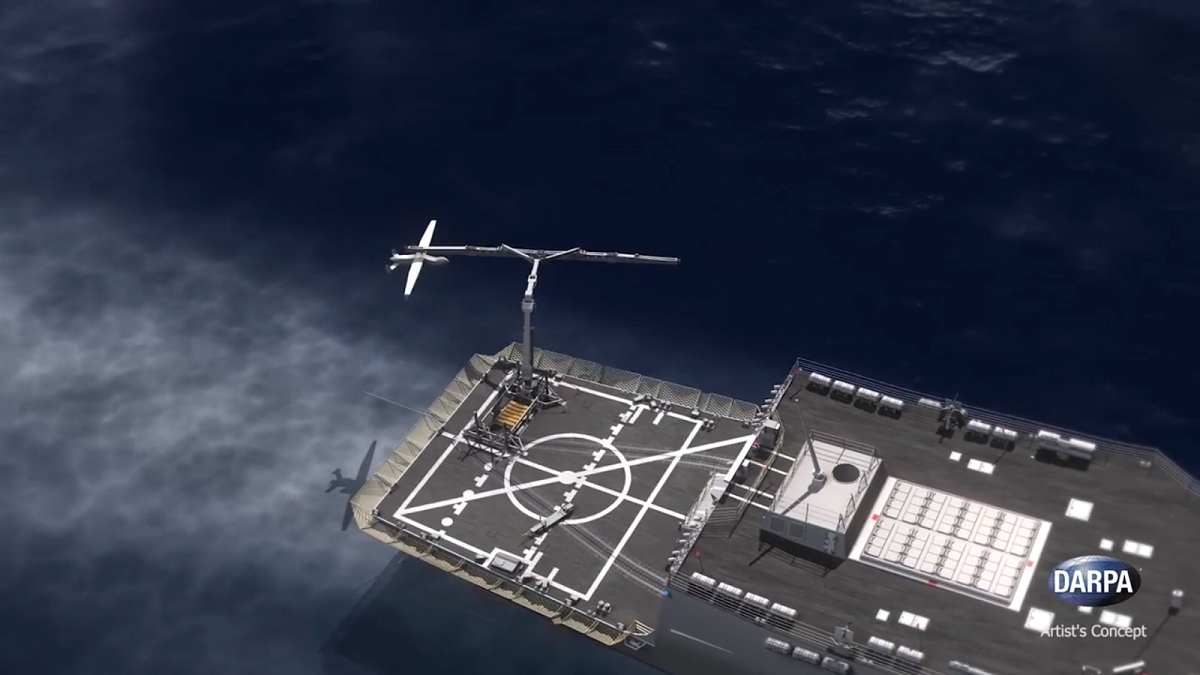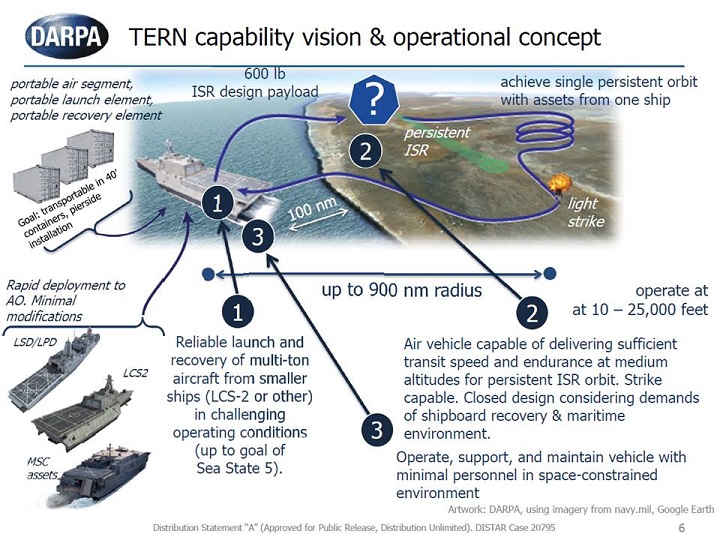Tactically Exploited Reconnaissance Node (TERN) UAS Program

Latest DARPA Concept
In March 2013, DARPA announced the Tactically Exploited Reconnaissance Node (TERN), a program designed to deploy a fixed-wing, medium-altitude, long- endurance (MALE) unmanned aerial system at sea from small U.S. Navy combatants. Technical objectives of the program include:
• Developing a launch and recovery technique to enable large aircraft operations from smaller ships, even in rough seas.
• Designing an aircraft compatible with the maritime environment with range and payload performance comparable to emerging land-based UAS.
• Ensuring the system can operate with minimal manning and shipboard modifications
• Packaging the system to fit into the limited space aboard ships such as the LCS-2 Independence Class.
DARPA intends to develop TERN over a forty month period, with three phases: I) Conceptual System Definition; II) Technical Maturation Phase; and III) Demonstration Phase, to include a full-scale launch and recovery demonstration.
Updates: DARPA expects to conduct initial land-based test flights of TERN in 2018, followed by sea-based testing.
DARPA TERN video

Earlier DARPA Concept
DARPA Demonstrates "Sidearm" Drone Capture System
6 February 2017 - In December 2016, Aurora Flight Sciences successfully tested a full-scale technology demonstration system that repeatedly captured a 400-pound Lockheed Martin Fury UAS accelerated to representative flight speeds via an external catapult. The system is capable of recovering aircraft up to 1,100 pounds, exceeding DARPA’s design objectives.
SideArm fits in the footprint of a standard 20-foot shipping container for easy transport by truck, ship, rail, C-130 transport aircraft, and CH-47 heavy-lift helicopter. The small-footprint system is designed to operate in truck-mounted, ship-mounted, and standalone/fixed-site facilities. A crew of only two to four people can set up or stow the system in minutes.
SideArm owes its small size to combining its launch and capture equipment into a single rail that folds for transport. Rather than using a traditional capture method that uses a net to catch the UAS, the system snags a hook on the back of the vehicle and directs the hook to travel down the rail. This approach provides slower, more constant and controlled deceleration, which is safer for the vehicle.

DARPA Image - Navy Destroyer with SideArm
“SideArm aims to replicate carriers’ capability to quickly and safely accelerate and decelerate planes through a portable, low-cost kit that is mission-flexible, independent from local infrastructure, and compatible with existing and future tactical unmanned aircraft,” said Graham Drozeski, DARPA program manager. “We’ve demonstrated a reliable capture mechanism that can go anywhere a 20-foot container can go—the DARPA-worthy challenge we had to overcome to make SideArm’s envisioned capabilities possible. We are pleased with the progress we’ve made enabling a wide variety of sea- and land-based platforms with persistent intelligence, surveillance, and reconnaissance (ISR) and strike capabilities.”
SideArm is part of DARPA’s individual investment in Phase 1 research for Tern, a joint program between DARPA and the U.S. Navy’s Office of Naval Research (ONR). Now that demonstration of the capture system is complete, DARPA is working to identify potential transition partners and exploring using SideArm with other UAS platform. (Source: DARPA)
Northrop Grumman Awarded $93 Million TERN Contract
24 December 2015 - Northrop Grumman has been awarded a $93.08 million contract by DARPA to develop a full scale demonstrator of the long endurance unmanned Tactically Exploited Reconnaissance Node (TERN) air vehicle designed to fly surveillance missions from naval vessels.
The prototype aircraft will be a flying wing helicopter design with large counter-rotating propellers, similar to the experimental Lockheed XFY-1 "Pogo" tailsitter flown in the 1950s. “The design we have in mind for the Tern demonstrator could greatly increase the effectiveness of any host ship by augmenting awareness, reach and connectivity,” said Dan Patt, DARPA program manager. “We continue to make progress toward our goal to develop breakthrough technologies that would enable persistent ISR and strike capabilities almost anywhere in the world at a fraction of current deployment costs, time and effort.”
AeroVironment Eliminated from DARPA Long Range UAV Competition
22 September 2015 - AeroVironment today announced it was informed by the Defense Advanced Research Projects Agency (DARPA) that the company was not selected to receive a phase III contract for DARPA’s Tern program. The announcement came after a competition for the phase III contract following successful phase I and II efforts.
“Our team developed a truly innovative approach to addressing DARPA’s requirements, but our customer elected not to pursue our proposed solution,” said Kirk Flittie, AeroVironment vice president and general manager of its Unmanned Aircraft Systems business segment. “We thank DARPA for the opportunity to apply our innovation toward developing a next generation unmanned aircraft system to protect United States Navy personnel. We are grateful for the outstanding contributions of our employees and our business partners in this endeavor.”
The company indicated the impact of this decision is immaterial to its previously announced fiscal year 2016 guidance and revenue neutral for the phase III performance period as a result of the company’s proposed funded research and development approach.
DARPA Awards Prime Contracts for TERN UAV
24 March 15 - DARPA has awarded prime contracts for Phase 2 of TERN, a joint program between DARPA and the U.S. Navy’s Office of Naval Research (ONR) to AeroVironment, Inc., and Northrop Grumman Corporation.
The goal of TERN is to give forward-deployed small ships the ability to serve as mobile launch and recovery sites for medium-altitude, long-endurance unmanned aerial systems (UAS). These systems could provide long-range intelligence, surveillance and reconnaissance (ISR) and other capabilities over greater distances and time periods than is possible with current assets, including manned and unmanned helicopters. Further, a capacity to launch and retrieve aircraft on small ships would reduce the need for ground-based airstrips, which require significant dedicated infrastructure and resources.
“To offer the equivalent of land-based UAS capabilities from small-deck ships, our Phase 2 performers are each designing a new unmanned air system intended to enable two previously unavailable capabilities: one, the ability for a UAS to take off and land from very confined spaces in elevated sea states and two, the ability for such a UAS to transition to efficient long-duration cruise missions,” said Dan Patt, DARPA program manager. “Tern’s goal is to develop breakthrough technologies that the Navy could realistically integrate into the future fleet and make it much easier, quicker and less expensive for the Defense Department to deploy persistent ISR and strike capabilities almost anywhere in the world.”
The first two phases of the Tern program focus on preliminary design and risk reduction. In Phase 3, one performer will be selected to build a full-scale demonstrator Tern system for initial ground-based testing. That testing would lead to a full-scale, at-sea demonstration of a prototype UAS on an at-sea platform with deck size similar to that of a destroyer or other surface combat vessel.
DARPA Awards Contract to Aurora to Develop SideArm Technology for TERN
7 October 2014 – Aurora Flight Sciences announced today that it has been awarded a contract from the Defense Advanced Research Projects Agency (DARPA) for the accelerated development of its SideArm launch and recovery system.
Demonstration of the SideArm technology was a key part of Aurora's work on the Tactically Enhanced Reconnaissance Node (TERN) program. Aurora's Phase 1 Tern results indicated that SideArm could fulfill needs for aircraft launch and recovery as part of Tern’s goal of developing technology that would enable small ships to serve as mobile launch and recovery sites for medium-altitude, long-endurance unmanned aerial systems (UAS). DARPA has awarded a contract for the continued development of this technology. The Aurora SideArm program includes integration and testing of SideArm technology, which would enable rapid transition to military utilization.
“Aurora developed the SideArm technology to a high degree of maturity in Phase 1 of Tern,” stated Graham Drozeski, Aurora program manager. “We have a path where continued development of the technology could make a near-term impact. The SideArm program focuses efforts on that opportunity.”
The SideArm technology supports launch and recovery of a range of tactical unmanned aircraft, including existing platforms and platforms under development.
"The SideArm system could provide runway independence to fixed-wing unmanned air systems (UAS) as part of Tern’s vision," said Aurora Chief Technology Officer Tom Clancy. "This is a driver for responsive and persistent intelligence, surveillance and reconnaissance (ISR) coverage of remote targets almost anywhere."
DARPA Awards Second Phase II Naval UAV Contract to AeroVironment
24 September 2014 - DARPA awarded a contract in the amount of $19,035,007.00 to AeroVironment, Inc. in support of the sea-based Tactically Exploited Reconnaissance Node (TERN) Unmanned Aerial Vehicle. This contract amount is similar to the Phase II award recently announced for Northrop Grumman Systems Corporation.
DARPA Awards Phase II Ship-based UAV Contract to Northrop Grumman
22 September 2014 - DARPA has awarded a Phase II contract in the amount of $19,267,875 to Northrop Grumman Systems Corporation to for the ship-based Tactically Exploited Reconnaissance Node (TERN) Unmanned Aerial Vehicle.
Phase II of the TERN program will continue preliminary design and risk reduction began in Northrop's $2.8 million Phase I contract. If selected for Phase III, Northrop will build a working prototype aircraft for ground testing and an eventual at sea launch and recovery demonstration.
DARPA and ONR to Team on Long Range Ship-based UAV
13 June 2014 - DARPA and the Office of Naval Research (ONR) recently signed a Memorandum of Agreement (MOA) on a joint DARPA/Navy research and development program called “Tern.” This joint effort builds upon the existing work of DARPA’s Tactically Exploited Reconnaissance Node program, or “TERN,” which has been exploring concepts for a long-endurance and long-range aircraft that would operate from a variety of Navy ships.
Modern warfare requires the ability to conduct airborne intelligence, surveillance and reconnaissance (ISR) and strike mobile targets anywhere and at any time. Current technologies in these areas, however, have their limitations. Helicopters are relatively limited in their distance and flight time, and long-distance fixed-wing manned and unmanned aircraft require either aircraft carriers or large, fixed land bases for takeoff and landing.
To help overcome these challenges, the Tern program envisions using smaller ships as mobile launch and recovery sites for medium-altitude, long-endurance unmanned aerial systems (UAS). The goal is to provide long-range ISR and other capabilities from the decks of forward-deployed small ships. The program aims to advance technology to enable a full-scale, at-sea demonstration of an R&D prototype UAS from a vessel with the same deck size as an Arleigh Burke-class destroyer.
“Having a signed agreement with a military Service at the outset of a program is an ideal approach to align objectives,” said Daniel Patt, DARPA program manager for the Tern program. “Ideally, this collaboration with ONR could serve as a model for similar agreements with all the Services for other DARPA programs, and help create breakthrough capabilities for military users.”
The Navy is providing a deputy program manager for Tern.
“This represents a new approach to providing long-range, long-endurance aircraft based off Navy ships,” said Gil Graff, deputy Tern program manager from the Office of Naval Research.
The first two phases of the program focus on preliminary design and risk reduction for the Tern system. Five performers are currently under contract for Phase 1. One or more of these performers may be selected to continue in Phase 2. In Phase 3, one performer would be selected to build a full-scale demonstrator Tern system for ground-based testing, culminating in an at-sea demonstration of launch and recovery.
Aurora Flight Sciences Awarded DARPA UAV Contract
23 October 2013 - Aurora Flight Sciences today announced that the Defense Advanced Projects Research Agency (DARPA) has awarded it a $2,811,232 contract for the Tactically Exploited Reconnaissance Node (TERN) program.
The objective of the DAPRA TERN program is to design, develop, and demonstrate a medium-altitude long-endurance (MALE) unmanned aircraft system (UAS) and related technologies to enable future launch, recovery, and operations from a wide range of existing US Navy ships.
Aurora would design a deployable UAS capable of launch and recovery from small naval ships. Leveraging innovative autonomous flight control technology originally developed for Aurora's Orion UAS and Centaur Optionally Piloted Aircraft (OPA), Aurora would take a systems level approach to address the challenges of capture dispersion, capture load management, and ship-board integration with a minimal on-board footprint.
"Aurora's TERN solution would be a disruptive technology capable of transforming how the US Navy conducts operations in the 21st century," said Dr. John S. Langford, Aurora's CEO and founder. "TERN would enable unmanned air vehicles with significant payload capabilities to operate from a large number of ships that do not have runways."
Aurora's industry team includes leading experts in shipboard integration, naval operations, robotics, and flight controls. The Aurora approach meets or exceeds all of the TERN program requirements while offering DARPA a potentially innovative and low-risk solution that could be affordably transitioned to the warfighter.
DARPA Awards Additional TERN Contracts
6 September 2013 -The Defense Advanced Research Projects Agency (DARPA) has announced additional awardees for Phase I of the ship-based Tactically Exploited Reconnaissance Node (TERN) unmanned aerial vehicle program. AeroVironment Inc. was awarded a $2.3 million contract, Northrop Grumman System Corporation $2.8 million, and Carter Aviation Technologies, LLC $2.2 million. A second solicitation will be issued during the first phase of the program to the Phase I awardees.
Other companies that had shown initial interest in the TERN program include Aurora Flight Sciences, Austal USA, BAE Systems, Boeing, General Atomics, Insitu, L-3 Communications, Lockheed Martin, Logos Technologies, Raytheon, ReconRobotics, Rockwell Collins, Science Applications International Corporation, Sierra Nevada Corporation, Sikorsky, Space Systems/Loral, and Teledyne.
DARPA Awards First Phase I TERN UAV Contract
25 August 2013 - The U.S. Defense Advanced Research Projects Agency (DARPA) awarded a $2.2 million contract to Baltimore-based Maritime Applied Physics Corp. (MAPC) for the initial phase of the Tactically Exploited Reconnaissance Node (TERN) ship-board unmanned air vehicle program.
MAPC will study designs for an operational TERN UAV in Phase I, and plan for a prototype flight demonstration in 2017. DARPA expect to award several Phase I contracts totaling up to $8.9 million.
DARPA Broad Agency Announcement Details TERN Requirements
26 MAR 13 - DARPA has released some new details for the proposed Tactically Exploited Reconnaissance Node (TERN) UAV. TERN will be designed to operate from an LCS-2 class or ship with a similar-sized flight deck in up to sea state 5. Some other desired attributes of the TERN include the ability to carry a 600 pound ISR payload over a 900 nautical mile radius operating at 10-25,000 feet altitude. This range would enable TERN to reach 95% of the world's land area from a 100 nautical mile stand-off.
In a presentation for the Proposers’ Day program, Dr. Daniel Patt, TERN Program Manager outlined how solution developers might overcome some of the physics governing the launch and recovery of aircraft from small ships. Helicopters traditionally utilize self power to take off and land vertically. TERN would be modeled more after smaller tactical UAS such as ScanEagle, in which a catapult on the ship rapidly increases the kinetic energy of the air vehicle and a recovery device mitigates the speed and energy of the recovering aircraft.

The vehicle should have a modular payload capability to rapidly changeout sensors which would support variety of missions, including persistent ISR and strike over both land and sea.
The TERN Phase I project will award multiple contracts of up to $8.9 million develop conceptual design trade studies for an operational TERN design and derive a demonstration system design and technology maturation plan to achieve flight by 2017. Proposals in response to the BAA are due May 13, 2013.
comments powered by Disqus